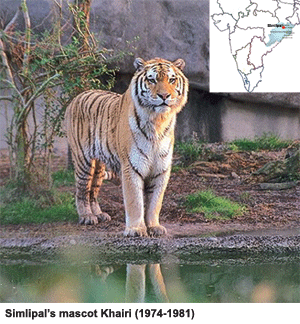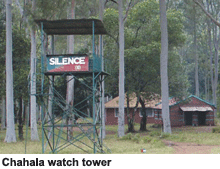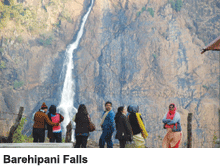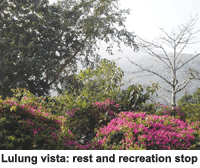Renowned for its blazing red silk cotton blooms, shaded by flame of the forest tree cover and extravagantly praised by oriya poet Radhanath Ray, the salmali saila (‘hills of simul’) are Orissa’s pride. Amrita Bose recounts a recent visit to this pristine conservation biosphere
 Deriving its lyrical name from the simul or silk cotton trees of the region, the Simlipal Tiger Reserve is located in the Mayurbhanj district of the eastern seaboard state of Orissa (pop.36 million). Renowned for its blazing red silk cotton blooms and shaded by flame of the forest tree cover, this abundant forest hides its secrets in hilly ranges, grass meadows and plateaus, and thousands of sal, semul and palash trees. Extravagantly praised by famous Oriya poet Radhanath Ray in his well-known poetic paean Usha, the salmali saila (‘hills of Simul’) are Orissa’s pride.
Deriving its lyrical name from the simul or silk cotton trees of the region, the Simlipal Tiger Reserve is located in the Mayurbhanj district of the eastern seaboard state of Orissa (pop.36 million). Renowned for its blazing red silk cotton blooms and shaded by flame of the forest tree cover, this abundant forest hides its secrets in hilly ranges, grass meadows and plateaus, and thousands of sal, semul and palash trees. Extravagantly praised by famous Oriya poet Radhanath Ray in his well-known poetic paean Usha, the salmali saila (‘hills of Simul’) are Orissa’s pride.
Spread over 2,200 sq.km including core and buffer areas, this deep and gigantic forest replete with wildlife, is ripe for exploration. Declared a national park and sanctuary by the state government in 1979, initially an area of 303 sq. km was proposed for the national park. However, the size was gradually increased to 845 sq. km in 1986, and in 1994, Simplipal was designated a biosphere reserve. Moreover to implement the eco-development scheme of the buffer zone, two neighbouring forest ranges of Baripada and Karanjia were amalgamated into the tiger reserve.
Today the Simlipal Tiger Reserve encompasses 2,750 sq. km within the larger biosphere reserve covering an area of 4,374 sq. km. Straggling across several hill ranges and valleys, this conservation biosphere boasts almost 1,000 species of flowering plants, 94 varieties of orchids and is the natural habitat of wildlife such as leopards, wild cat, wild boar, civet cat, dhole (wild dog), wolves, bear, bison, sambhar, deer, porcupine, pangolin, flying squirrels, crocodiles and snakes. Gliding over the forest are a large number of birds including hill mynah, the crescent serpent eagle, the jungle fowl, pea fowl and the grey hornbill. Yet the undisputed king and star attraction of the entire biosphere is the majestic (and elusive) Royal Bengal Tiger (RBT), with the reserve’s herds of wild elephants discharging the role of silent courtiers.
According to the latest census conducted by the Simlipal adminis-tration in January 2009, the current tiger population of the reserve is 150. According to field director R. Nagaraj Reddy, the census was conducted using the pug mark method, and the 25 distinctive pug marks translate into approximately 150 RBTs. This claim is refuted by the Wildlife Institute of India whose independent census conducted by the camera trap methodology indicates a tiger population of less than 30 within the reserve.
Although the anarchic violence of Maoist insurgents in the region and its dwindling wildlife has reduced the appeal of the reserve in recent years, the thrill and excitement of living in the lap of nature and roughing it out minus the comforts of luxury resorts and convenience of electricity, can only be experienced in the Simlipal Tiger Reserve.
Simlipal is also famous for Khairi, the tiger cub rescued and adopted by Indian Forest Service officer and field director the late Saroj Raj Chaudhury in 1974. The two-month-old hungry and weak female Khairi was brought to Chaudhury by some Khaira tribals of Simlipal. Together with a sloth bear, hyena, snake and a pet dog, Khairi grew up to become a majestic RBT, and mascot of the Project Tiger movement of Simlipal during the 1970s. As such, she was as much an attraction as the forest itself until she died in 1981. Chaudhury’s home has since been converted into a museum, which functions as the office of the field director in Baripada.
Chahala
 A former hunting lodge of the maharajas of Mayurbhanj, Chahala is the first stop of visiting tourists and a vantage point for ample game spotting. The lodge comprises a cluster of log huts and a watch tower overlooking a fenced off area separated by a moat, where animals visit a salt lick constructed in a clearing. Everyday at about 4 in the afternoon monkeys, peacocks, wild hen, deer and sometimes a stampede of elephants visit the lick. With the sparse grassland vegetation of the cleared hunting lodge offering an unimpeded view of the salt lick, there is a good chance of visitors espying peacocks, elephants and perhaps the stripes of the big cat crossing a stream at dusk.
A former hunting lodge of the maharajas of Mayurbhanj, Chahala is the first stop of visiting tourists and a vantage point for ample game spotting. The lodge comprises a cluster of log huts and a watch tower overlooking a fenced off area separated by a moat, where animals visit a salt lick constructed in a clearing. Everyday at about 4 in the afternoon monkeys, peacocks, wild hen, deer and sometimes a stampede of elephants visit the lick. With the sparse grassland vegetation of the cleared hunting lodge offering an unimpeded view of the salt lick, there is a good chance of visitors espying peacocks, elephants and perhaps the stripes of the big cat crossing a stream at dusk.
Bordered by towering eucalyptus trees that perfume the forest with their strong fragrance, the lodges are modestly furnished but offer a wonderful ambience and refreshing sleep.
Accommodation. (Mid range & budget): The E-Villa: Rs.800 for four people per night; Chahala C Villa, dormitory style for eight people (Rs.600 per night) and Sal villa (Rs.1,200 for two people per night).
Barehipani
 For visitors to Simlipal, a not-to-be-missed spot is the Barehipani Falls. One of the tallest waterfalls in the world (217 metres), Barehipani derives its name from its rope-like shape (barehi translates into ‘rope’). With its distinctive form, it uncoils from a great height to drop deep into a gorge of the River Budhabalanga. A watch tower built into a cliff opposite the falls offers a great view with a picnic spot. An alternative and equally scenic vista is from a wooden bungalow, raised on stilts.
For visitors to Simlipal, a not-to-be-missed spot is the Barehipani Falls. One of the tallest waterfalls in the world (217 metres), Barehipani derives its name from its rope-like shape (barehi translates into ‘rope’). With its distinctive form, it uncoils from a great height to drop deep into a gorge of the River Budhabalanga. A watch tower built into a cliff opposite the falls offers a great view with a picnic spot. An alternative and equally scenic vista is from a wooden bungalow, raised on stilts.
Accommodation. Currently under renovation, reservations for this tourist bungalow can be made from the field director’s office.
Newana
One of the unique characteristics of the Simlipal Tiger Reserve is its various enclaves within the biosphere, where Mother Nature is manifested in diverse and magnificent apparitions. While Chahala is sited in the heart of deep forest, the Barehipani waterfall gushes out of a steep cliff. On the other hand, Newana is an expanse of lush valleys and grasslands. Beyond, a road threads through the valley and disappears into a thicket of sal trees from where starts Devasthali, the core area of Simlipal where tourists are not permitted. A cluster of villages thrive around the Newana valley, flanked by a sparkling stream that flows to the bottom of the valley.
Accommodation. Dormitory accomm-odation in the Newana valley near the stream is available at Rs.300 per night. There’s also a guest house bungalow situated atop a hill with two rooms (Rs.300 per night). This accommodation is strictly for nature lovers who aren’t fastidious about hygiene and creature comforts including security. For the more particular, a day trip is advisable.
Joranda
 Sited on the edge of a cliff facing an enormous water-fall that falls 181 metres, Joranda offers great vistas and a closer encounter with the forest. Indeed the woods are lovely, dark and deep, but they take on an ominous character after nightfall, for Joranda is the haunt of panthers, tigers, elephants, sambhar and deer. A salt lick located across a moat attracts wildlife, and there’s a good chance of glimpsing it after sundown.
Sited on the edge of a cliff facing an enormous water-fall that falls 181 metres, Joranda offers great vistas and a closer encounter with the forest. Indeed the woods are lovely, dark and deep, but they take on an ominous character after nightfall, for Joranda is the haunt of panthers, tigers, elephants, sambhar and deer. A salt lick located across a moat attracts wildlife, and there’s a good chance of glimpsing it after sundown.
Unlike Chahala which boasts a beat office and patrolling forest officials, Joranda is absolute wilderness with only a forest guard or two doing the rounds, equipped with sticks to deal with poachers and timber thieves.
Accommodation. Jordana has recently built new tourist cottages along the precipice of the rock face. For reservations, contact the Field Director’s Office at Baripada (Tel: 0679 2252593).
Gurguria
Situated on the banks of the river Khairi, Gurguria is a laid back hamlet with the ambience of a hill station. It is a destination in the buffer zone of Simlipal, with rambling jungle tracks ideal for nature walks and treks. An orchidarium displays 63 indigenous varieties of orchids found in the biosphere.
Accommodation. Toshali Jungle Lodge: Rs.760 per night onwards. Contact Amit Das + 91 9777121473.
Lulung
 One of the entry points of the Simlipal Tiger Reserve, Lulung is located on the periphery of the core area and is a rest and recreation stop after the strenuous excursions in Simlipal or the larger biosphere. Rising 300 metres (984.25 ft) above sea level with hills glimmering in the distance, Lulung offers a welcome and much-needed break to nerves and limbs after trekking in Simlipal.
One of the entry points of the Simlipal Tiger Reserve, Lulung is located on the periphery of the core area and is a rest and recreation stop after the strenuous excursions in Simlipal or the larger biosphere. Rising 300 metres (984.25 ft) above sea level with hills glimmering in the distance, Lulung offers a welcome and much-needed break to nerves and limbs after trekking in Simlipal.
Accommodation. Hotel Aranyanivas of The Orissa Tourism Development Corporation (OTDC) offers non-AC rooms at Rs.1,000 per night inclusive of bed tea and breakfast. Contact OTDC head office on (91-674) 2430764.
Getting to Simlipal
By Air. The nearest airports are Kolkata (240 km) and Bhubaneshwar (270 km).
By Rail. Baripada is the railhead and is 50 km by road. It is connected to all major Indian cities such as Delhi, Mumbai, Chennai and Kolkata.
By Road. Lulung and Joshipur are the two main entry points for tourists visiting Simlipal. Buses from Baripada to Lulung (30 km) and Joshipur (65 km) are available at all times. Private taxis can also be hired from Baripada.
Entry requirements
• Entry permits to the park can be collected from the Baripada office of the Field Director, Simlipal Tiger Project. Applications should be made at least a month in advance in writing or by email with proof of identity. Post confirmation, the letter has to be shown at the Simlipal Park Office (06792 52393) in Baripada and entry permits are issued on the spot. The entry fee for Indian nationals is Rs.40. Foreigners have to pay Rs.100. Light motor vehicles are charged Rs.100 daily. All confirmations for entry into Simlipal must be reconfirmed at the Simlipal Park Office (Tel: 06792 52593), Baripada.
• Trained guides are available from Baripada. For reservation in tourist lodges in Chahala, Barehipani, Newana and Joranda, contact the Assistant Conservator Forests, Tourism, Baripada on 0679 2255931 or Range Officer, National Park, Joshipur on 0679 7232474 at least 10 days in advance. Further details can be obtained from the Field Director on 0679 2252593/260773 or e-mail simidig@sancharnet.in.